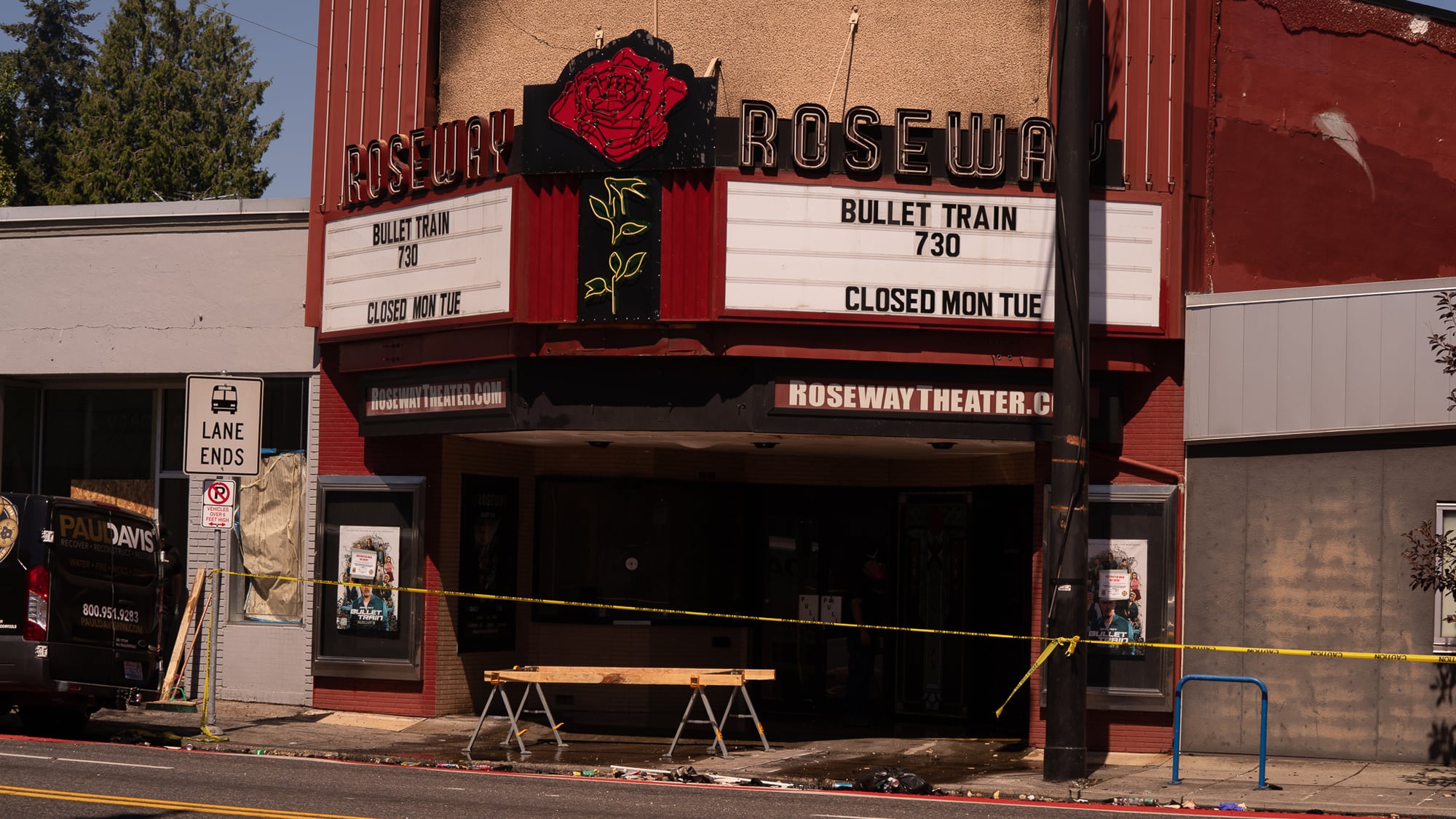From the moment word spread of the three-alarm fire that devastated Northeast Sandy Boulevard’s Roseway Theater on Aug. 6, grief swept through Portland. Regular patrons and long-lost émigrés shared vague remembrances, but genuine sorrow lay beneath the performative trauma.
Flames engulfing a neighborhood landmark beloved by generations should tug the heartstrings, of course, but this wasn’t quite a tragedy. Nobody was injured and 80 firefighters made sure the blaze never threatened additional buildings. Nevertheless, as details emerged about the totality of the structural damage, public mourning for the Roseway felt intensely personal.
“Coming home from my morning jog and seeing a dozen fire trucks and huge smoke billowing from the direction of my house was pretty terrifying,” says Alex Kennedy, host of The Devil Made Me Do It podcast. “The theater was always a great place to go with my daughter. She’s a teenager now, so it’s hard to get her to do anything with me, but we’d walk to Roseway in silence, join our neighbors laughing or cheering, and always walk home with smiles on our faces.”
The Roseway has stayed a neighborhood movie theater until damn near spitting distance from its centenary, despite barely any neighborhood to draw from. That’s extremely rare in itself—doubly so for a business stranded amid a perennially parking-starved wisp of a commercial hub.
Given the theater’s awkward location and relatively anonymous charms, its stubborn endurance over the past few decades seems nothing short of miraculous. (In the 1950s, just about every silent-era cinema gave away its theater organ. In the ‘70s, the Roseway brought its back.)
The Roseway’s launch (a soft opening Oct. 15, 1924, with The Fast Worker, followed by an official debut Friday, Oct. 16, with The Signal Tower) wasn’t especially newsworthy, but trade publications spoke well of the 589-seat theater’s “artistic design.”
Although the first few years were marked by a smattering of wildly eclectic attractions (including a runway show of the latest cotton and silk styles from Milady’s Toggery), the live acts soon dwindled as the theater kept pace with innovations.
Early 1941 brought the first significant renovations (to the foyer, stairway and general lounge). By the following spring, the theater had joined the war effort, adding a female manager and a “candy bar matinee” for servicemen.
A dozen years later, the Roseway bid farewell to its balcony and organ to become the fifth Portland theater boasting a Cinemascope screen and stereoscopic sound. After flames sparked by a defective popcorn machine gutted the foyer and damaged the interior in 1957, colorful local drive-in impresario Jesse Jones oversaw a complete rebuild at costs equivalent to the low six figures.
Signs of wear began to show following Jones’ 1968 death. Vandals hurled an object through the screen, which turned out to be uninsured. A screening of American Hot Wax showed the reels out of order, though attendance was so sparse no one noticed during consecutive screenings.
“The Roseway was not doing well,” recalls longtime resident Marty McCray. “My cousin was just down the block here, and I remember seeing Lawrence of Arabia, A Hard Day’s Night, all that kind of stuff. It was always a nice neighborhood theater up until the ‘70s, but, in terms of showing movies, the business went into disarray.”
McCray’s father ran a neighboring electronics store where the young guitarist would host rehearsals after hours for his band The Offering—and the Roseway’s ongoing troubles inspired a potential opportunity.
“The owner of this arcade next door…keeps listening to us and comes up with this idea: ‘Hey, we got this great band next door to a [struggling] theater. Let’s start putting on concerts—like a mini-Fillmore or something, you know?’” McCray says. “So, 1977, we did two concerts there onstage—light show, all that kind of stuff.”
Although The Offering would soon splinter, McCray spent the next 50 years as a musician performing at Portland-area clubs. Pete Holmes, their drummer during the Roseway shows, co-founded Beaverton-to-Sunset Strip glam-rock group Black ‘n Blue alongside longtime Kiss lead guitarist Tommy Thayer.
Following stints with Peter Gabriel and Ted Nugent, Holmes now drums for the latest incarnation of Ratt. As for the Roseway, McCray recalls that “they revamped the theater in the 1980s. It didn’t really catch on.”
What about now? “My first inkling is, yes, hopefully we can rebuild it,’” Roseway owner Greg Wood told WW in August. “But to be honest, it’s also overwhelming.” After surviving a near-century, it remains to be seen if the Roseway will bloom again.
